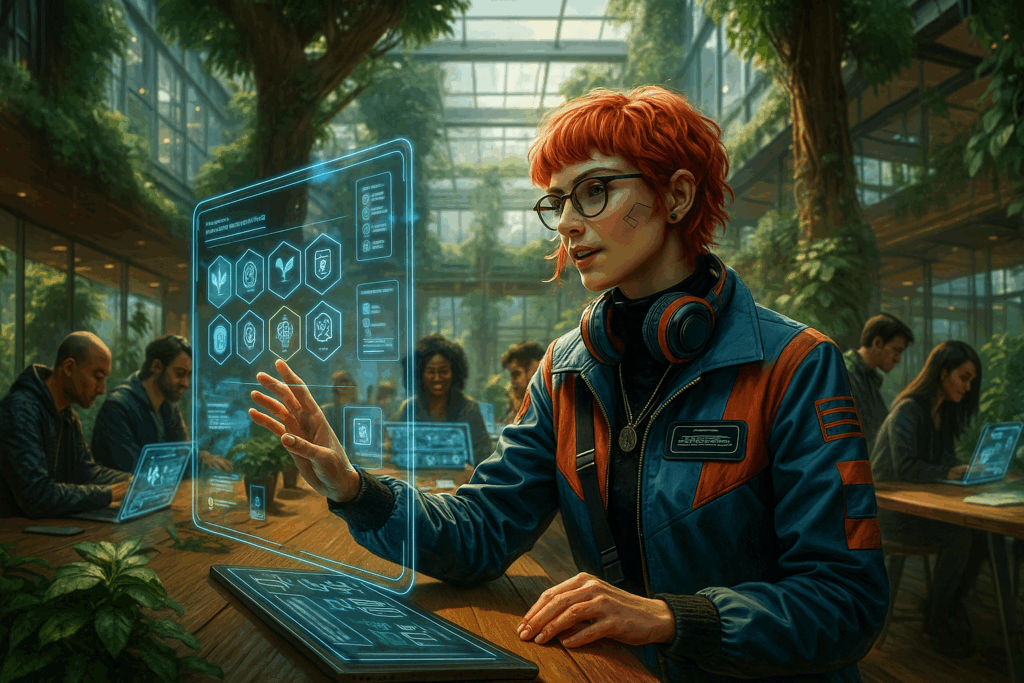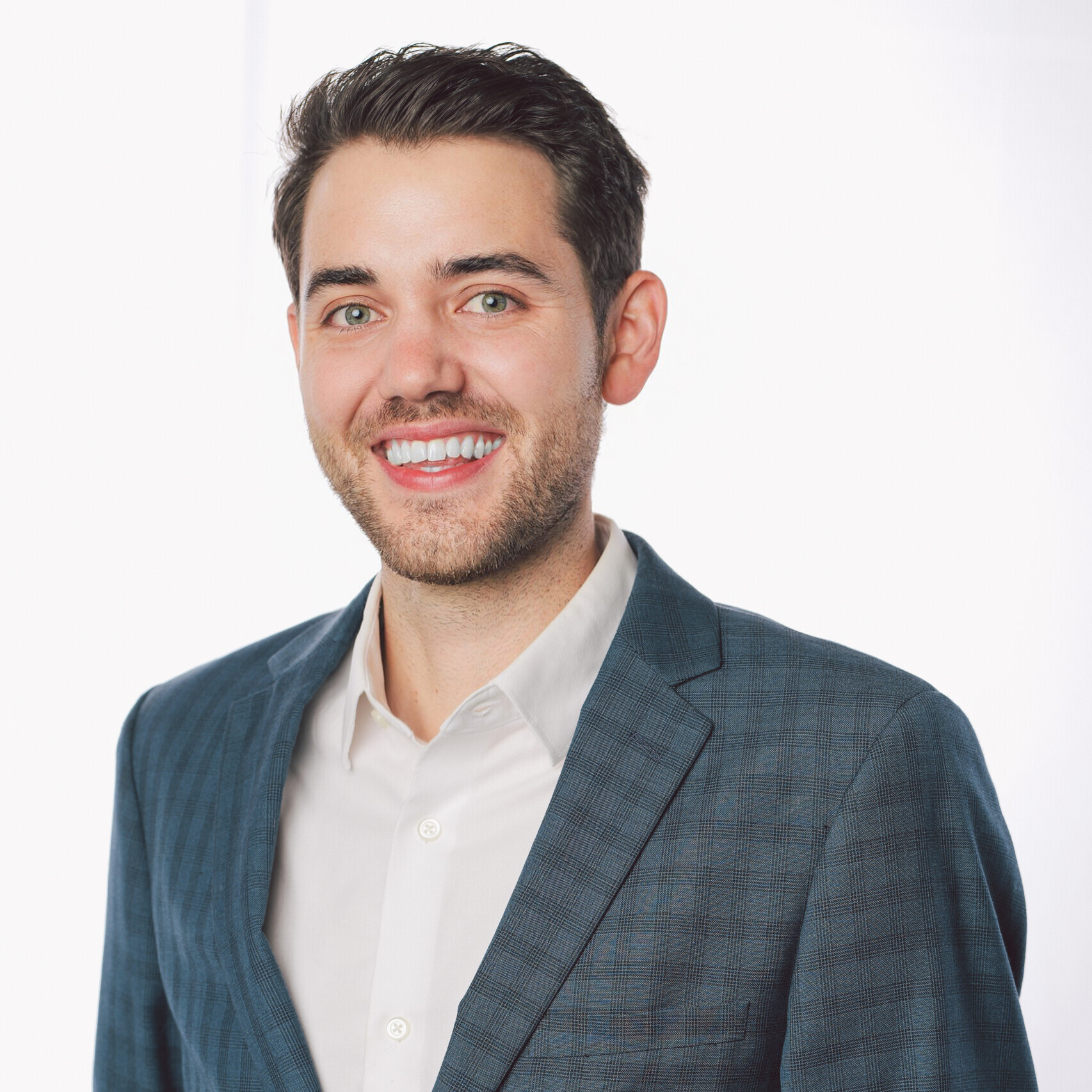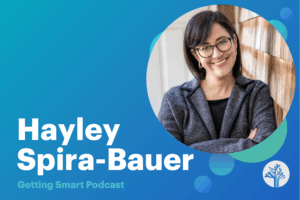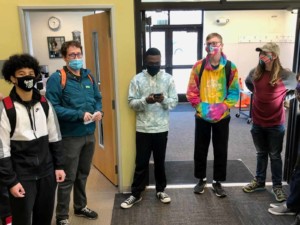What Did I Do “At School” Today? A Learner from 2040 Tells All
Key Points
-
Future learning environments will prioritize unbundled, city-wide educational ecosystems, integrating AI and technology to personalize learning paths for individuals, thereby enhancing educational outcomes.
-
The shift towards lifelong learning opportunities and personalized education allows for a flexible, interest-driven approach, empowering learners to navigate and thrive in a rapidly changing world.

Jamie, a fictional young person in 2040, wrote this piece to reflect on her high school experience.
You know, when my grandma tells me about her childhood, it sounds so… structured. One school building, one classroom, one teacher for everything. School happened “inside” those walls. Every. Day. For my mom, not much changed. She had a couple of teachers, but I was shocked at how similar the pictures looked.
In 2040, it’s super different. I don’t think anyone would mistake our current learning environment with those old, dated ones. Oh, you turned a chalkboard into a whiteboard? Cool. At risk of blowing your mind, let me tell you about my high school experience, one where the city becomes the classroom, and the learning is completely unbundled. I live in a registered “Learning Ecosystem”, a growing movement around the world, and every part of it feels designed to help me, and everyone around me, learn and grow. It’s a collective vision of possibility for all its citizens.
Waking Up in a Connected City
My day starts not with a rush to class, but an interaction with my personalized AI, Scout, who has a direct interface with my digital learner wallet, a life-spanning record of growth and interests (don’t worry, I get to control what everyone else sees).
We have a conversation over breakfast, which is … oatmeal. Ok, not everything has changed. Last week I finished a big project at the local community center, so today I get to figure out what I’ll do next. Scout prompts first, always forcing me to think for myself… so hard. To help facilitate my curiosity, Scout is showing me my customized learning path—a map, of sorts, that tells where I’ve been, where I’m going, the big questions that I’ve added to my curiosity dashboard, and the requirements for/progress on various credentials, including graduation.
A week or so ago, I was talking to a friend about streetlights. Funnily, they haven’t changed much in the last 20 years; they just have a more reddish hue at night now to detract from the light pollution and negative impacts on flying critters. Anyway, we got to talking and my friend mentioned something about bioluminescence—light coming from organic things like water. It got me curious, so I’m popping over to the science lab to see if anyone has thought about what that might mean for urban lighting and design. It could be nothing, but, either way, that’s still valuable information for my learner record. Scout recommends that I stop by a “Learning Ecosystem Partner” — an architecture firm downtown that has a community co-design space in the lobby. They were one of the first businesses that started housing microschools in our city. I didn’t attend it, but one of my friends did.
While there are still options that my parents had, I personally don’t have a traditional school building. It works better for me to move at my own pace and have my learning experiences spread across a network of Learning Hubs/Partners throughout the city. This flexibility is key to how our Learning Ecosystem operates, reflecting a shift from scarcity to abundance. Learning happens everywhere, whether we want it to or not.
It’s not just the spaces, though. Our city, like many others, now boasts fast and accessible public Wi-Fi networks. It’s everywhere – on the streets, in parks, even on our public transit. My apartment building itself is quite innovative, with materials science advancements making it extremely energy-efficient, and even some of the bricks are bioengineered from mushrooms, which is … wild… ha. We’re growing and 3D printing so many of our buildings now. It has totally changed what it means to build, making it way faster, way easier and way cheaper to build and to live in… or so I’ve heard.
Real-World Learning and Finding a Mentor
I hop on an autonomous tram that glides along green tracks, connecting me effortlessly to my first learning destination. It’s critical for helping people, young and old, and everyone in between, access opportunities and connect meaningfully with the city. Our mayor always says, “If you build a city that works for 8-year-olds and for 80-year-olds, you build a city that works for everybody.”
While I’m on the tram, I reflect with my AI assistant Scout. They are interested in how my project wrapped up yesterday, and we had a conversation about what went well, what I thought I learned, and how it has changed the way I think about my future. Truthfully, I’m not sure, but it did ask me to reflect on some things I had said a few weeks and months ago about personally struggling with one of my classmates. It wanted to know if that had improved and how we had overcome obstacles to work together.
All of this data gets processed on the backend and added to my learner record. Not bad for a commute.
The tram pulls up to the downtown station, right near the new Eco-Tower, a massive skyscraper, and the latest addition to the Living Building Challenge list. The architecture firm, ‘Urban Bloom Design,’ occupies the lower floors, and their entrance proudly displays a “Learning Ecosystem Partner” badge. Inside, it’s not what I expected. The lobby opens directly into a bright, airy community workspace filled with various individuals and small groups deeply engaged in projects. There’s a buzzing energy.
I find an open station at one of the large, interactive design tables. I put Scout in co-design mode, and I do some digging on recent street design projects. From a few keyword searches, I can’t find bioluminescence anywhere, so I start pulling up simulations, leveraging the firm’s cutting-edge AI design tools. I incorporated some research I found on various bioluminescent organisms, aiming to visualize how their light production could be scaled for urban environments. My goal: to design a conceptual living streetlight that uses biological processes instead of electricity. I pull up open-source architectural designs from the AI Commons to see how others have imagined organic structures, tweaking and iterating, seeing how different bio-materials might impact the aesthetic and functionality. This is truly learning by doing, creating something new. I’m actively co-creating alongside the firm’s professionals, even if they don’t know it yet.
I get so absorbed in trying to program the light’s intensity based on pedestrian traffic patterns—a complex challenge—that I barely notice someone standing over my shoulder.
“Fascinating,” a voice says.
I look up to see a man with kind eyes and a thoughtful expression, a name tag identifying him as ‘Mr. Davies, Urban Bloom Design.’ He’s looking intently at my holographic design.
“That’s an intriguing approach to streetlights,” he continues, gesturing to my evolving design. “Are you exploring a new energy source, or is it more about the aesthetic?”
I take a deep breath, gathering my thoughts. “Both, I guess?” I explain, my confidence growing as I articulate my ideas. “I feel like bioluminescence could be a sustainable, clean energy lighting source. But also, how the organic nature of it could integrate with bioengineered city structures, creating a different kind of urban landscape—one that’s more alive.” I point to a section where I’m simulating light diffusion through mushroom-derived building panels.
Mr. Davies nods slowly, a genuine smile spreading across his face. “Remarkable,” he says.
He glances at my LER, visible briefly on the screen, seeing the badges for “iterative design” and “systems thinking” I’ve earned from other projects. His eyes light up. “This is exactly the kind of innovation our firm champions,” he says, almost to himself. Then, looking back at me, he asks, “Jamie, would you be interested in having an informal mentor for this project? I’d be happy to guide you, offer some professional insights, and perhaps even connect you with some of our materials science team.”
My heart does a little leap. A real architect, offering to be my mentor! “Absolutely, Mr. Davies!” I beam. As he gives me his contact information, Scout buzzes, and I see a notification pop up on my LER: “New Mentorship Connection: Mr. Davies, Lead Urban Architect, Urban Bloom Design.” It’s automatically logged, a verified stamp of this incredible, spontaneous learning moment. This is what it means to be an “Experienced Citizen” in 2040. My city truly is my classroom
A Lifelong Learning Marketplace
As you might have guessed, instead of just one school system, there are tons of different, symbiotic providers – microschools like mine, local businesses offering apprenticeships, community centers with workshops, and even online platforms. I have a personal learning fund that empowers my family and I to choose what works best for me at any given time, whether it’s a single class or a full program in the public system. This expanded marketplace means I have many more options to learn in ways that fit my interests and goals, which is why our city is designed to work for young people, and therefore, it works for all people.
What’s even cooler is that this unbundling isn’t just for kids. It’s for everyone. My mom, for instance, is a marketing professional, and the “Workforces of the Future” are responding to skills gaps and a reorganization of post-high school success. Her company is shifting towards more AI-driven analytics, and she needs to upskill. Between her employer and the city, her lifelong learning is fully funded – they see education as a key retention and pipeline development strategy. She’s earning new digital credentials in “Advanced Predictive Modeling” and “AI Ethics for Business,” which are then seamlessly added to her LER. It’s a formal way of showing her new skills, even though she’s taking the classes completely online, on her own schedule.
Then there’s my older brother, Liam. He used to be a traditional construction manager, building skyscrapers the old way. But with so many new buildings being 3D printed and bio-integrated, he wanted a change. He’s enrolled in an intensive program at our local makerspace, focusing on “Bio-Fabrication Systems Technician” certification. He’s learning how to manage autonomous robotic swarms that 3D print living structures and maintain complex bio-integrated systems. It’s amazing to see how quickly he’s gaining hands-on expertise in a completely new field – truly one of the trades of the future.
Heck, even my grandma is obsessed with learning new things. She’s currently taking piano lessons at her shared living facility. She says she wants to play like Thelonius Monk. Good luck.
The concept of lifelong learning is built into the city’s very fabric, recognizing informal learning and providing access to reskilling and upskilling for everyone. Our public education system’s customer base isn’t just K-12 now; it includes everyone who can benefit from local educational assets. It’s truly about creating a society rich in adaptability and opportunity.
From here, I’m going offline to hangout with friends at the waterfront. I don’t think I need to tell you about that, though, as we kinda just do the same stuff. Walk, talk, eat… glimmercast. Oh, right, you may not know that one yet. I’ll save that for another entry.
Signals from the Future
This possible future was based on the following signals from communities and projects around the world.
An Aspirational City: Seattle’s Downtown is You is a radical activation plan rooted in maker spaces, arts districts, thriving small businesses and public areas for co-creation, leisure and learning. Initiatives like this one are starting across the country.
A Connected City: Cities like New York, Seattle, Dallas and Austin offer fast and accessible public wi-fi networks. Additionally, we saw public school busses be used as hotspots during the pandemic to increase access to distance learning for many learners.
An Efficient City: In Malawi, students were welcomed to the first 3D printed school back in 2021. This school was printed in a mere 18 hours and was able to meet a scarcity of school buildings.
A Bioengineered City: Clay school in Rajasthan uses local clay to keep rooms temperate and even cool during the sweltering summer heat. Additionally, materials science has advanced such that we can now make bricks out of mushrooms to build resilient and adaptive structures. Coming soon to a school near you.
A City-Wide Campus. Tacoma Public School has a network of three specialized high schools providing a wide range of students with an entirely unique high school experience. The schools are called The School of Industrial Design, Engineering and Art (IDEA), Science and Math Institute (SAMI), and School of the Arts (SOTA), and the three campuses are located in three distinct locations within the city:
- IDEA – A repurposed alternative school that had been vacant and bare for a number of years, which has now been converted into a learning workshop where students engage in engineering, design and entrepreneurial pursuits.
- SAMI – Tucked away inside Point Defiance Zoo (which is itself housed within a state park) sharing space with the zookeepers and providing students with direct access to learn within the walls of the zoo and the trails and water access of the park.
- SOTA – In a number of smaller locations throughout the city’s downtown core and theater district, many of them former art performance or business spaces filled with features like theater seating and dance floors, and connected by downtown sidewalks, streets and light transit.
A Regenerative City: The Living Building Challenge certifies buildings that “give more than they can take.” These buildings are: regenerative buildings that connect occupants to light, air, food, nature, and community, self-sufficient and remain within the resource limits of their site, and reate a positive impact on the human and natural systems that interact with them.
A Young Workforce. CAPS Network is an affiliate network of 105 schools specializing in professional learning programs for young people. Their annual impact report boasts a large increase in both confidence and competence for their students.
A Solutionary Workforce. The Knowledge Society is a program that equips students with rapid exposure to mindsets, emerging technologies and global challenges. The students then put these elements together to create a solution to a purpose-driven problem.
An Experienced Citizen. with LivedX, a platform that enables students to input their experiences into a tool that uses AI to process the demonstrated durable skills and stacks them into skills certificates that are exchangeable for college credit.
A Greener Light Source. MIT scientists infused leaves with microscopic particles of strontium aluminate, a phosphorescent compound often used in glow-in-the-dark paints. These nanoparticles, only about 650 nanometers wide, were coated in silica to protect the plants from damage. Infused through stomata pores, these particles settle evenly across the mesophyll layer, forming a thin film. When illuminated briefly—just ten seconds—with blue LED lights, these nanoparticles absorb and store energy. Once charged, the plants emit a soft, visible glow lasting for nearly an hour. After the first few vibrant minutes, the glow gently fades but can be quickly recharged repeatedly over weeks, offering a sustainable lighting alternative.






0 Comments
Leave a Comment
Your email address will not be published. All fields are required.